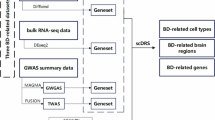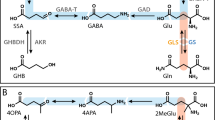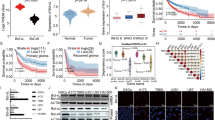Abstract
B-cell lymphoma 2 (Bcl-2) is an important regulator of cellular plasticity and resilience. In bipolar disorder (BD), studies have shown a key role for a Bcl-2 gene single-nucleotide polymorphism (SNP) rs956572 in the regulation of intracellular calcium (Ca2+) dynamics, Bcl-2 expression/levels, and vulnerability to cellular apoptosis. At the same time, Bcl-2 decreases glutamate (Glu) toxicity in neural cells. Abnormalities in Glu function have been implicated in BD. In magnetic resonance spectroscopy (MRS) studies, anterior cingulated cortex (ACC) Glu levels have been reported to be increased in bipolar depression and mania, but no study specifically evaluated ACC Glu levels in BD-euthymia. Here, we compared ACC Glu levels in BD-euthymia compared with healthy subjects using 1H-MRS and also evaluated the selective role of the rs956572 Bcl-2 SNP in modulating ACC Glu and Glx (sum of Glu and glutamine) in euthymic-BD. Forty euthymic subjects with BD type I and forty healthy controls aged 18–40 were evaluated. All participants were genotyped for Bcl-2 rs956572 and underwent a 3-Tesla brain magnetic resonance imaging examination including the acquisition of an in vivo PRESS single voxel (2 cm3) 1H-MRS sequence to obtain metabolite levels from the ACC. Euthymic-BD subjects had higher Glu/Cre (creatine) and Glx/Cre compared with healthy controls. The Bcl-2 SNP AA genotype was associated with elevated ACC Glu/Cre and Glx/Cre ratio in the BD group but not in controls. The present study reports for the first time an increase in ACC Glu/Cre and Glx/Cre ratios in BD-euthymia. Also, Bcl-2 AA genotype, previously associated with lower Bcl-2 expression and increase intracellular Ca2+, showed to be associated with increased ACC Glu and Glx levels in euthymic-BD subjects. The present findings reinforce a key role for glutamatergic system dysfunction in the pathophysiology of BD, potentially involving modulatory effects by Bcl-2 in the ACC.
Similar content being viewed by others
Log in or create a free account to read this content
Gain free access to this article, as well as selected content from this journal and more on nature.com
or
References
Ahmad S, Fowler LJ, Whitton PS (2005). Effects of combined lamotrigine and valproate on basal and stimulated extracellular amino acids and monoamines in the hippocampus of freely moving rats. Naunyn-Schmiedeberg's Arch Pharmacol 371: 1–8.
Altamura CA, Mauri MC, Ferrara A, Moro AR, D'Andrea G, Zamberlan F (1993). Plasma and platelet excitatory amino acids in psychiatric disorders. Am J Psychiatry 150: 1731–1733.
Beneyto M, Kristiansen LV, Oni-Orisan A, McCullumsmith RE, Meador-Woodruff JH (2007). Abnormal glutamate receptor expression in the medial temporal lobe in schizophrenia and mood disorders. Neuropsychopharmacology 32: 1888–1902.
Beneyto M, Meador-Woodruff JH (2008). Lamina-specific abnormalities of NMDA receptor-associated postsynaptic protein transcripts in the prefrontal cortex in schizophrenia and bipolar disorder. Neuropsychopharmacology 33: 2175–2186.
Bhagwagar Z, Wylezinska M, Jezzard P, Evans J, Ashworth F, Sule A et al (2007). Reduction in occipital cortex gamma-aminobutyric acid concentrations in medication-free recovered unipolar depressed and bipolar subjects. Biol Psychiatry 61: 806–812.
Chao DT, Korsmeyer SJ (1998). BCL-2 family: regulators of cell death. Annu Rev Immunol 16: 395–419.
Chen R, Valencia I, Zhong F, McColl KS, Roderick HL, Bootman MD et al (2004). Bcl-2 functionally interacts with inositol 1,4,5-trisphosphate receptors to regulate calcium release from the ER in response to inositol 1,4,5-trisphosphate. J Cell Biol 166: 193–203.
Colla M, Schubert F, Bubner M, Heidenreich JO, Bajbouj M, Seifert F et al (2009). Glutamate as a spectroscopic marker of hippocampal structural plasticity is elevated in long-term euthymic bipolar patients on chronic lithium therapy and correlates inversely with diurnal cortisol. Mol Psychiatry 14: 696–704, 647.
Drevets WC (2000). Functional anatomical abnormalities in limbic and prefrontal cortical structures in major depression. Prog Brain Res 126: 413–431.
Drevets WC, Ongür D, Price JL (1998). Neuroimaging abnormalities in the subgenual prefrontal cortex: implications for the pathophysiology of familial mood disorders. Mol Psychiatry 3 220–226, 190–191.
Drevets WC, Savitz J, Trimble M (2008). The subgenual anterior cingulate cortex in mood disorders. CNS Spectrums 13: 663–681.
DSM-IV, PATFO (2000) Diagnostic and Statistical Manual of Mental Disorders: DSM-IV-TR. American Psychiatric Publishing.
Du J, Suzuki K, Wei Y, Wang Y, Blumenthal R, Chen Z et al (2007). The anticonvulsants lamotrigine, riluzole, and valproate differentially regulate AMPA receptor membrane localization: relationship to clinical effects in mood disorders. Neuropsychopharmacology 32: 793–802.
Eastwood SL, Harrison PJ (2010). Markers of glutamate synaptic transmission and plasticity are increased in the anterior cingulate cortex in bipolar disorder. Biol Psychiatry 67: 1010–1016.
First MB, Spitzer RL, Williams JB (1996) Structured Clinical Interview for DSM-IV Axis I Disorders SCID-I. American Psychiatric Press: Washington, DC.
Foland-Ross LC, Thompson PM, Sugar CA, Madsen SK, Shen JK, Penfold C et al (2011). Investigation of cortical thickness abnormalities in lithium-free adults with bipolar I disorder using cortical pattern matching. Am J Psychiatry 168: 530–539.
Francis PT, Poynton A, Lowe SL, Najlerahim A, Bridges PK, Bartlett JR et al (1989). Brain amino acid concentrations and Ca2+-dependent release in intractable depression assessed antemortem. Brain Res 494: 315–324.
Friedman SD, Dager SR, Parow A, Hirashima F, Demopulos C, Stoll AL et al (2004). Lithium and valproic acid treatment effects on brain chemistry in bipolar disorder. Biol Psychiatry 56: 340–348.
Frye MA, Watzl J, Banakar S, O'Neill J, Mintz J, Davanzo P et al (2007). Increased anterior cingulate/medial prefrontal cortical glutamate and creatine in bipolar depression. Neuropsychopharmacology 32: 2490–2499.
Hamilton M (1960). A rating scale for depression. J Neurol Neurosurgery Psychiatry 23: 56–62.
Hammonds MD, Shim SS (2009). Effects of 4-week treatment with lithium and olanzapine on levels of brain-derived neurotrophic factor, B-cell CLL/lymphoma 2 and phosphorylated cyclic adenosine monophosphate response element-binding protein in the sub-regions of the hippocampus. Basic Clin Pharmacol Toxicol 105: 113–119.
Hashimoto K, Sawa A, Iyo M (2007). Increased levels of glutamate in brains from patients with mood disorders. Biol Psychiatry 62: 1310–1316.
Hashimoto R, Hough C, Nakazawa T, Yamamoto T, Chuang DM (2002). Lithium protection against glutamate excitotoxicity in rat cerebral cortical neurons: involvement of NMDA receptor inhibition possibly by decreasing NR2B tyrosine phosphorylation. J Neurochemistry 80: 589–597.
Hockenbery DM, Oltvai ZN, Yin XM, Milliman CL, Korsmeyer SJ (1993). Bcl-2 functions in an antioxidant pathway to prevent apoptosis. Cell 75: 241–251.
Hokin LE, Dixon JF, Los GV (1996). A novel action of lithium: stimulation of glutamate release and inositol 1,4,5 trisphosphate accumulation via activation of the N-methyl D-aspartate receptor in monkey and mouse cerebral cortex slices. Adv Enzyme Regul 36: 229–244.
Kim H-W, Rapoport SI, Rao JS (2010). Altered expression of apoptotic factors and synaptic markers in postmortem brain from bipolar disorder patients. Neurobiol Disease 37: 596–603.
Kim JS, Schmid-Burgk W, Claus D, Kornhuber HH (1982). Increased serum glutamate in depressed patients. Archiv für Psychiatrie und Nervenkrankheiten 232: 299–304.
Kumar A, Singh RL, Babu GN (2010). Cell death mechanisms in the early stages of acute glutamate neurotoxicity. Neurosci Res 66: 271–278.
Laitinen J, Samarut J, Hölttä E (1994). A nontoxic and versatile protein salting-out method for isolation of DNA. Biotechniques 17: 316–322.
Lan MJ, McLoughlin GA, Griffin JL, Tsang TM, Huang JT, Yuan P (2009). Metabonomic analysis identifies molecular changes associated with the pathophysiology and drug treatment of bipolar disorder. Mol Psychiatry 14: 269–279.
Lazarewicz JW, Salińska E (1993). Role of calcium in glutamate-mediated toxicity: mechanisms of calcium fluxes in rabbit hippocampus in vivo investigated with microdialysis. Acta Neurobiologiae Experimentalis 53: 3–13.
Levine J, Panchalingam K, Rapoport A, Gershon S, McClure RJ, Pettegrew JW (2000). Increased cerebrospinal fluid glutamine levels in depressed patients. Biol Psychiatry 47: 586–593.
Lien R, Flaisher-Grinberg S, Cleary C, Hejny M, Einat H (2008). Behavioral effects of Bcl-2 deficiency: implications for affective disorders. Pharmacol Rep 60: 490–498.
Liu J, Blond BN, van Dyck LI, Spencer L, Wang F, Blumberg HP et al (2012). Trait and state corticostriatal dysfunction in bipolar disorder during emotional face processing. Bipolar Disorders 14: 432–441.
Machado-Vieira R, Manji HK, Zarate CA (2009b). The role of the tripartite glutamatergic synapse in the pathophysiology and therapeutics of mood disorders. Neuroscientist 15: 525–539.
Machado-Vieira R, Pivovarova NB, Stanika RI, Yuan P, Wang Y, Zhou R et al (2011). The Bcl-2 gene polymorphism rs956572AA increases inositol 1,4,5-trisphosphate receptor-mediated endoplasmic reticulum calcium release in subjects with bipolar disorder. Biol Psychiatry 69: 344–352.
Machado-Vieira R, Salvadore G, Ibrahim LA, Diaz-Granados N et al (2009a). Targeting glutamatergic signaling for the development of novel therapeutics for mood disorders. Curr Pharmaceut Design 15: 1595–1611.
Manji H (2008). Bcl-2: A key regulator of affective resilience in the pathophysiology and treatment of severe mood disorders. Biol Psychiatry 63 (Suppl 1): 243S.
Manji HK, Moore GJ, Chen G (2000). Lithium up-regulates the cytoprotective protein Bcl-2 in the CNS in vivo: a role for neurotrophic and neuroprotective effects in manic depressive illness. J Clin Psychiatry 61 (Suppl 9): 82–96.
Mauri MC, Ferrara A, Boscati L, Bravin S, Zamberlan F, Alecci M et al (1998). Plasma and platelet amino acid concentrations in patients affected by major depression and under fluvoxamine treatment. Neuropsychobiology 37: 124–129.
Mitani H, Shirayama Y, Yamada T, Maeda K, Ashby CR, Kawahara R et al (2006). Correlation between plasma levels of glutamate, alanine and serine with severity of depression. Prog Neuro-Psychopharmacol Biol Psychiatry 30: 1155–1158.
National Center for Biotechnology Information (2012) dbSNP 2012th edn, Available at: http://www.ncbi.nlm.nih.gov/projects/SNP/snp_ref.cgi?rs=956572 (accessed 18 July 2012).
Nierenberg AA, DeCecco LM (2001). Definitions of antidepressant treatment response, remission, nonresponse, partial response, and other relevant outcomes: a focus on treatment-resistant depression. J Clin Psychiatry 62 (Suppl 16): 5–9.
Ongur D, Ferry AT, Price JL (2003). Architectonic subdivision of the human orbital and medial prefrontal cortex. J Comparative Neurol 460: 425–449.
Ongur D, Jensen JE, Prescot AP, Stork C, Lundy M, Cohen BM et al (2008). Abnormal glutamatergic neurotransmission and neuronal-glial interactions in acute mania. Biol Psychiatry 64: 718–726.
Ongür D, Drevets WC, Price JL (1998). Glial reduction in the subgenual prefrontal cortex in mood disorders. Proc Natl Acad Sci USA 95: 13290–13295.
Phillips ML, Drevets WC, Rauch SL, Lane R (2003). Neurobiology of emotion perception I: The neural basis of normal emotion perception. Biol Psychiatry 54: 504–514.
Provencher SWS (1993). Estimation of metabolite concentrations from localized in vivo proton NMR spectra. Magnet Resonance Med 30: 672–679.
Provencher (2012). LCModel and LCM gui User’s Manual. Available at http://s-provencher.com/pages/lcm-manual.shtml.
Salvadore G, Nugent AC, Chen G, Akula N, Yuan P, Cannon DM et al (2009). Bcl-2 polymorphism influences gray matter volume in the ventral striatum in healthy humans. Biol Psychiatry 66: 804–807.
Scarr E, Pavey G, Sundram S, MacKinnon A, Dean B (2003). Decreased hippocampal NMDA, but not kainate or AMPA receptors in bipolar disorder. Bipolar Disorders 5: 257–264.
Senaratne R, Milne AM, MacQueen GM, Hall GB (2009). Increased choline-containing compounds in the orbitofrontal cortex and hippocampus in euthymic patients with bipolar disorder: a proton magnetic resonance spectroscopy study. Psychiatry Res 172: 205–209.
Sheehan DV, Lecrubier Y, Sheehan KH, Amorim P, Janavs J, Weiller E et al (1998). The Mini-International Neuropsychiatric Interview (M.I.N.I.): the development and validation of a structured diagnostic psychiatric interview for DSM-IV and ICD-10. J Clin Psychiatry 59 (Suppl 20) 22–33; quiz 34–57.
Tohen M, Jacobs TG, Grundy SL, McElroy SL, Banov MC, Janicak PG et al (2000). Efficacy of olanzapine in acute bipolar mania: a double-blind, placebo-controlled study. The Olanzipine HGGW Study Group. Arch General Psychiatry 57: 841–849.
Uemura T, Green M, Corson TW, Perova T, Li PP, Warsh JJ (2011). Bcl-2 SNP rs956572 associates with disrupted intracellular calcium homeostasis in bipolar I disorder. Bipolar Disorders 13: 41–51.
Wang J-F, Shao L, Sun X, Young LT (2009). Increased oxidative stress in the anterior cingulate cortex of subjects with bipolar disorder and schizophrenia. Bipolar Disorders 11: 523–529.
Yatham LN, Kennedy SH, Schaffer A, Parikh SV, Beaulieu S, O'Donovan C et al (2009). Canadian Network for Mood and Anxiety Treatments (CANMAT) and International Society for Bipolar Disorders (ISBD) collaborative update of CANMAT guidelines for the management of patients with bipolar disorder: update 2009. Bipolar Disorders 11: 225–255.
Young RC, Biggs JT, Ziegler VE, Meyer DA (1978). A rating scale for mania: reliability, validity and sensitivity. British J Psychiatry 133: 429–435.
Yüksel C, Ongur D (2010). Magnetic resonance spectroscopy studies of glutamate-related abnormalities in mood disorders. Biol Psychiatry 68: 785–794.
Zarate C, Machado-Vieira R, Henter I, Ibrahim L, Diazgranados N, Salvadore G (2010). Glutamatergic modulators: the future of treating mood disorders? Harv Rev Psychiatry 18: 293–303.
Zhong LT, Kane DJ, Bredesen DE (1993). BCL-2 blocks glutamate toxicity in neural cell lines. Brain research. Molecular Brain Res 19: 353–355.
Zimmermann AK, Loucks FA, Schroeder EK, Bouchard RJ, Tyler KL et al (2007). Glutathione binding to the Bcl-2 homology-3 domain groove: a molecular basis for Bcl-2 antioxidant function at mitochondria. J Biol Chemistry 282: 29296–29304.
Acknowledgements
We would like to thank the members of Mood Disorders Unit (GRUDA) and Laboratory of Neuroscience (LIM27), Institute of Psychiatry, University of Sao Paulo for their hard work, as well as the volunteers for their collaboration. We also thank Sao Paulo Research Foundation (Fapesp) and Associação Beneficente Alzira Denise Hertzog da Silva (ABADHS). This study was financed by Sao Paulo Research Foundation (Fapesp). Dr Salvadore is a full time employee of Janssen pharmaceutical company. Dr Moreno has acted as a consultant to and conducted research sponsored by companies with developments in the area of bipolar and depressive disorders (Servier, BMS, Eli Lilly, Abbott, Astra Zêneca, GSK) and received research grants from Research Foundation Support Agency of the State of Sao Paulo, Brazil (FAPESP). Dr Zarate is listed as a co-inventor on a patent application for the use of ketamine and its metabolites in major depression. Dr Zarate has assigned his rights in the patent to the US government but will share a percentage of any royalties that may be received by the government. Dr Zarate is also the recipient of the Brain & Behavior Research Foundation Award. Dr Machado-Vieira has received research grants from Research Foundation Support Agency of the State of Sao Paulo, Brazil (FAPESP). We declare that, except for income received from our primary employer, no financial support or compensation has been received from any individual or corporate entity over the past 3 years for research or professional service.
Author information
Authors and Affiliations
Corresponding author
Ethics declarations
Competing interests
The authors declare no conflict of interest.
Additional information
Supplementary Information accompanies the paper on the Neuropsychopharmacology website
Rights and permissions
About this article
Cite this article
Soeiro-de-Souza, M., Salvadore, G., Moreno, R. et al. Bcl-2 rs956572 Polymorphism is Associated with Increased Anterior Cingulate Cortical Glutamate in Euthymic Bipolar I Disorder. Neuropsychopharmacol 38, 468–475 (2013). https://doi.org/10.1038/npp.2012.203
Received:
Revised:
Accepted:
Published:
Issue date:
DOI: https://doi.org/10.1038/npp.2012.203
Keywords
This article is cited by
-
Bcl-2 Overexpression Induces Neurite Outgrowth via the Bmp4/Tbx3/NeuroD1 Cascade in H19-7 Cells
Cellular and Molecular Neurobiology (2020)
-
Genetic variant in SLC1A2 is associated with elevated anterior cingulate cortex glutamate and lifetime history of rapid cycling
Translational Psychiatry (2019)
-
Associations of Bcl-2 rs956572 genotype groups in the structural covariance network in early-stage Alzheimer’s disease
Alzheimer's Research & Therapy (2018)
-
Unique prefrontal GABA and glutamate disturbances in co-occurring bipolar disorder and alcohol dependence
Translational Psychiatry (2017)
-
The CACNA1C risk allele rs1006737 is associated with age-related prefrontal cortical thinning in bipolar I disorder
Translational Psychiatry (2017)



